⎈ A Hands-On Guide to Kubernetes Logging Using Grafana Loki ⚙️
⇢ A Comprehensive Guide to Setting Up the Grafana Loki on Kubernetes with Helm: Practical Example
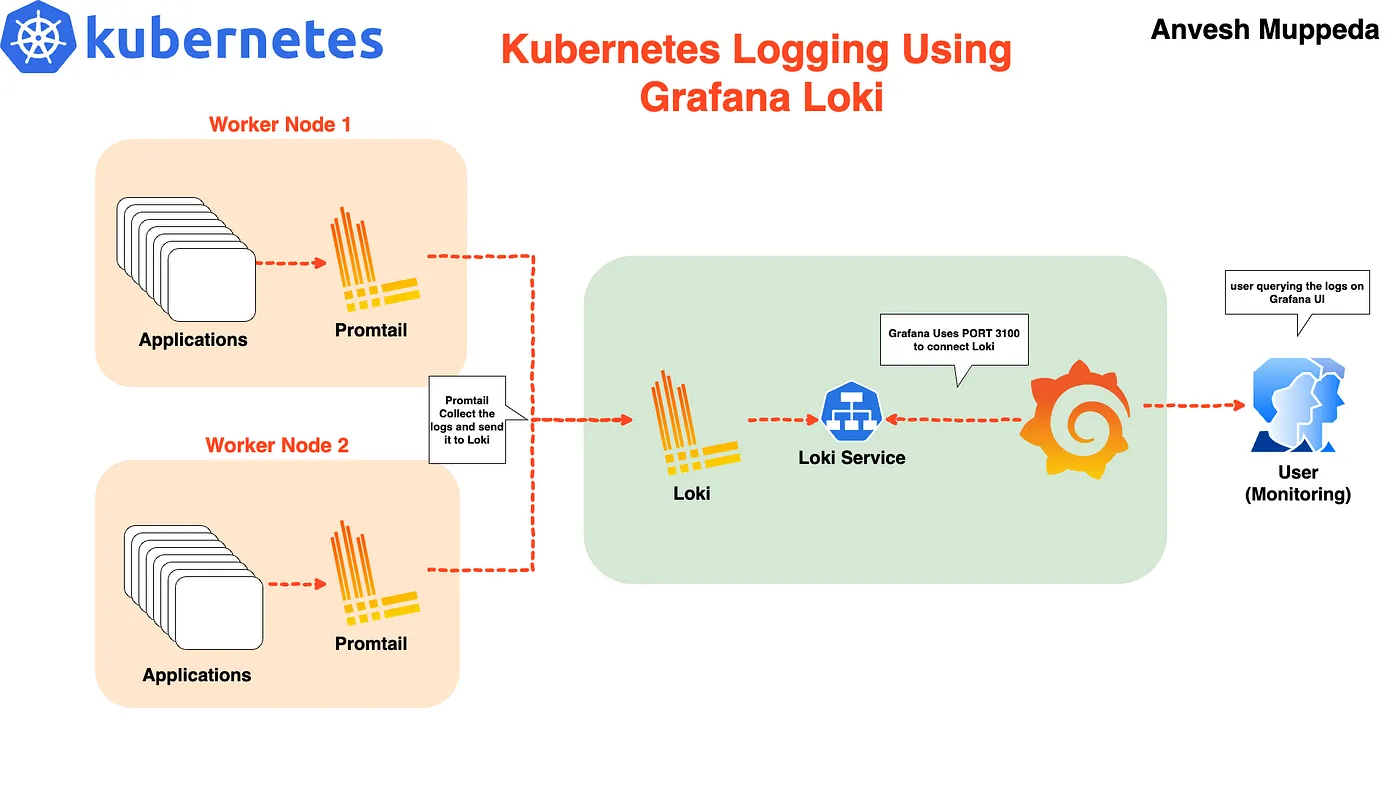
In a microservices architecture, monitoring and logging are essential to keep track of various components. Kubernetes generates a large number of logs, and managing them effectively is key to running a healthy cluster. Grafana Loki is a highly efficient logging solution that integrates seamlessly with Grafana for visualizing logs, allowing you to query and explore logs from multiple sources in one place.
In this guide, I’ll walk you through setting up Grafana Loki in a Kubernetes cluster using Helm, a package manager for Kubernetes. We will use the Loki Stack, which comes bundled with Loki, Promtail, and optionally Grafana.
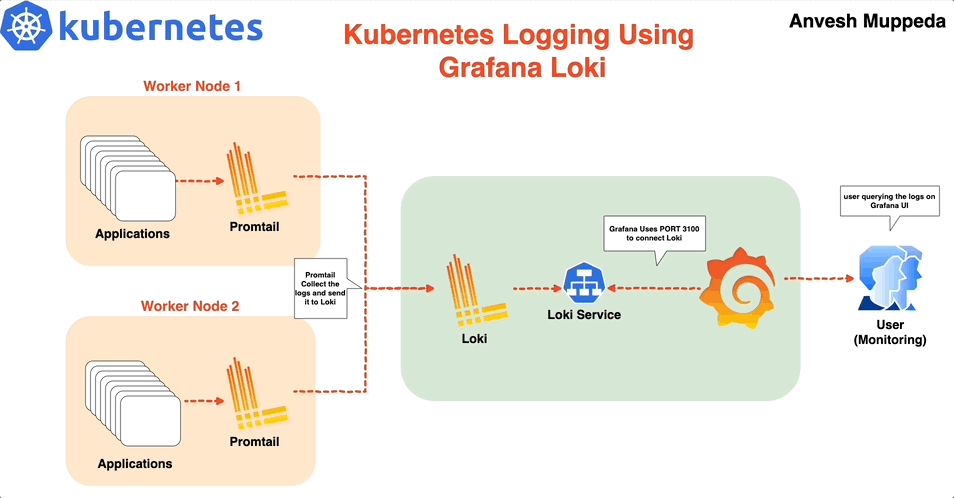
Prerequisites
Before starting, make sure you have:
- A Kubernetes cluster up and running
- Helm installed on your system
- kubectl configured to interact with your cluster
Steps to Set Up Grafana Loki on Kubernetes
Once you have the prerequisites in place, follow the steps below to set up Grafana Loki using Helm.
Step 1: Add the Grafana Helm Repository
The first step is to add the Grafana Helm repository, which contains the Helm chart for deploying Loki.
Run the following command to add the Grafana repo to Helm:
helm repo add grafana https://grafana.github.io/helm-charts
After adding the repository, it’s a good practice to update the Helm repo to ensure you have the latest chart versions. Use the command:
helm repo update
Now, list every repository with the word “Loki” in it by running:
helm search repo loki
You should see several results, but we will be using the grafana/loki-stack repository to deploy Promtail and Grafana, and to configure Loki.
Step 2: Customize Helm Chart Configuration Values
Before deploying Loki, you may want to customize some of the default values in the Helm chart. This step is especially important if you want to install Grafana alongside Loki or configure other advanced features like persistent storage.
First, download the default values of the Loki Helm chart into a YAML file by running:
helm show values grafana/loki-stack > loki-custom-values.yaml
Now, open the loki-values.yaml file and make the following changes to meet your specific configuration needs.
Here is the custom loki-custom-values.yaml file:
test_pod:
enabled: true
image: bats/bats:1.8.2
pullPolicy: IfNotPresent
loki:
enabled: true
isDefault: true
url: http://{{(include "loki.serviceName" .)}}:{{ .Values.loki.service.port }}
readinessProbe:
httpGet:
path: /ready
port: http-metrics
initialDelaySeconds: 45
livenessProbe:
httpGet:
path: /ready
port: http-metrics
initialDelaySeconds: 45
datasource:
jsonData: "{}"
uid: ""
promtail:
enabled: true
config:
logLevel: info
serverPort: 3101
clients:
- url: http://{{ .Release.Name }}:3100/loki/api/v1/push
fluent-bit:
enabled: false
grafana:
enabled: true
sidecar:
datasources:
label: ""
labelValue: ""
enabled: true
maxLines: 1000
image:
tag: 10.3.3
service:
type: NodePort
prometheus:
enabled: false
isDefault: false
url: http://{{ include "prometheus.fullname" .}}:{{ .Values.prometheus.server.service.servicePort }}{{ .Values.prometheus.server.prefixURL }}
datasource:
jsonData: "{}"
filebeat:
enabled: false
filebeatConfig:
filebeat.yml: |
# logging.level: debug
filebeat.inputs:
- type: container
paths:
- /var/log/containers/*.log
processors:
- add_kubernetes_metadata:
host: ${NODE_NAME}
matchers:
- logs_path:
logs_path: "/var/log/containers/"
output.logstash:
hosts: ["logstash-loki:5044"]
logstash:
enabled: false
image: grafana/logstash-output-loki
imageTag: 1.0.1
filters:
main: |-
filter {
if [kubernetes] {
mutate {
add_field => {
"container_name" => "%{[kubernetes][container][name]}"
"namespace" => "%{[kubernetes][namespace]}"
"pod" => "%{[kubernetes][pod][name]}"
}
replace => { "host" => "%{[kubernetes][node][name]}"}
}
}
mutate {
remove_field => ["tags"]
}
}
outputs:
main: |-
output {
loki {
url => "http://loki:3100/loki/api/v1/push"
#username => "test"
#password => "test"
}
# stdout { codec => rubydebug }
}
# proxy is currently only used by loki test pod
# Note: If http_proxy/https_proxy are set, then no_proxy should include the
# loki service name, so that tests are able to communicate with the loki
# service.
proxy:
http_proxy: ""
https_proxy: ""
no_proxy: ""
Key Points in Custom Configuration:
- Loki is enabled and configured with readiness and liveness probes for health checking.
- Promtail is enabled to forward logs from Kubernetes nodes to Loki.
- Grafana is enabled with a NodePort service to allow access to the Grafana UI from outside the cluster.
- Prometheus, Filebeat, and Logstash are explicitly disabled.
Step 3: Deploy the Loki Stack with Custom Values
After editing the loki-cusomt-values.yaml file, you are ready to deploy the Loki stack. Use the following command to install or upgrade the Helm release:
helm upgrade --install --values loki-custom-values.yaml loki grafana/loki-stack -n grafana-loki --create-namespace
This command:
- Deploys the Loki, Promtail, and Grafana components.
- Disables the Prometheus, Filebeat, and Logstash components as per the configuration.
- Creates a namespace grafana-loki and deploys all components inside this namespace.
Step 4: Access Grafana and Configure Data Source
Once the Helm chart has been successfully deployed, it’s time to access Grafana and verify that everything is working correctly.
- First, check the pods in the grafana-loki namespace to ensure everything is running:
$ kubectl get pods -n grafana-loki
NAME READY STATUS RESTARTS AGE
loki-0 1/1 Running 0 19m
loki-grafana-567d65596c-gvt5q 2/2 Running 0 17m
loki-promtail-8jng6 1/1 Running 0 19m
loki-promtail-hb6x2 1/1 Running 0 19m
- Find the NodePort assigned to Grafana:
$ kubectl get svc loki-grafana -n grafana-loki -o jsonpath="{.spec.ports[0].nodePort}"
30287
This command retrieves the NodePort assigned to Grafana, which you will use to access the Grafana web interface.
- Access Kibana:
Open your web browser and navigate to:
http://<EXTERNAL-IP>:<NODE-PORT>
Replace EXTERNAL-IP with the IP address of your Kubernetes cluster and NODE-PORT with the NodePort value obtained in step 1
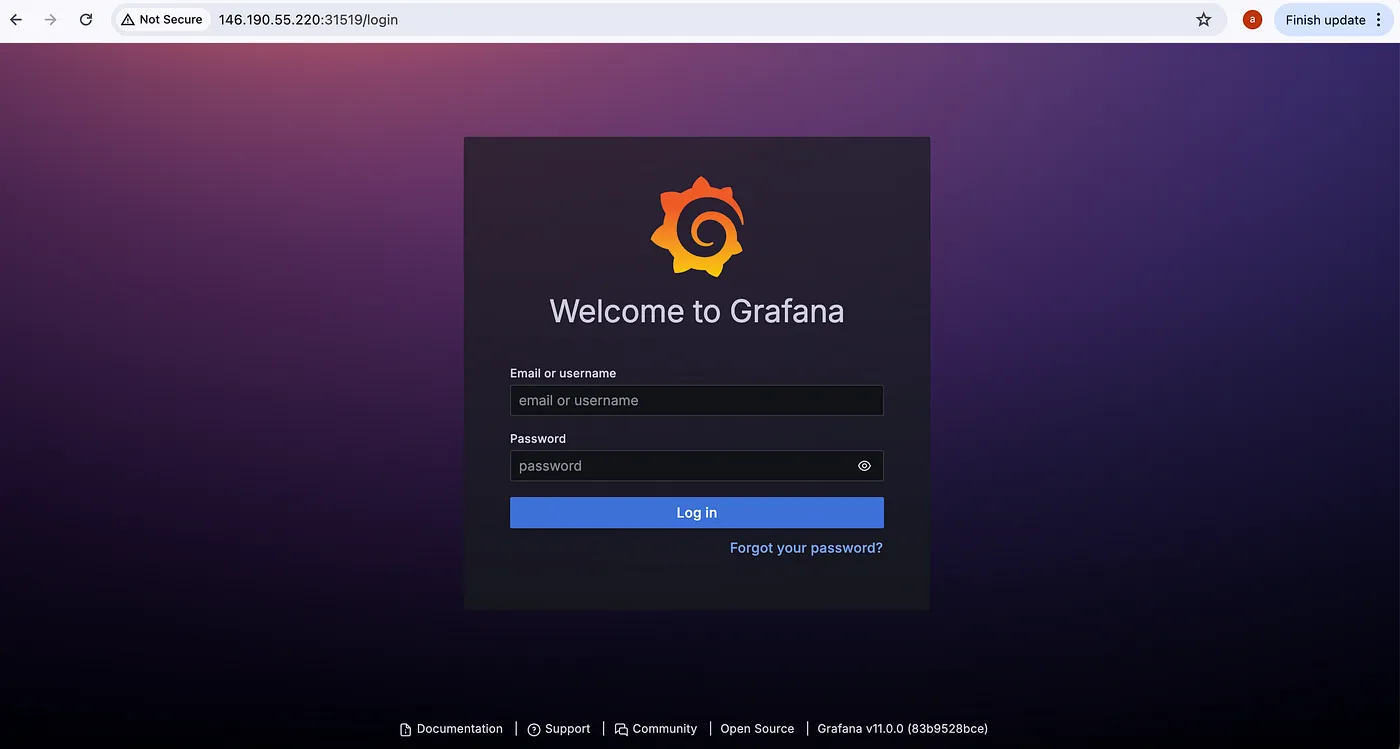
- Log in to Grafana:
You can get the login credentials for Grafana from the loki-grafana secret using the below commands.
$ kubectl get secret loki-grafana -n grafana-loki -o jsonpath="{.data.admin-user}" | base64 --decode
admin
$ kubectl get secret loki-grafana -n grafana-loki -o jsonpath="{.data.admin-password}" | base64 --decode
C43ICy6t22dwI3W93DsDPiiSUeX5Z4aHMwKWkNvq%
Once you log in you can see the home screen of Grafana, press the three lines at the top left corner you can see the menu then go to Connections > Data sources as shown in the below image.
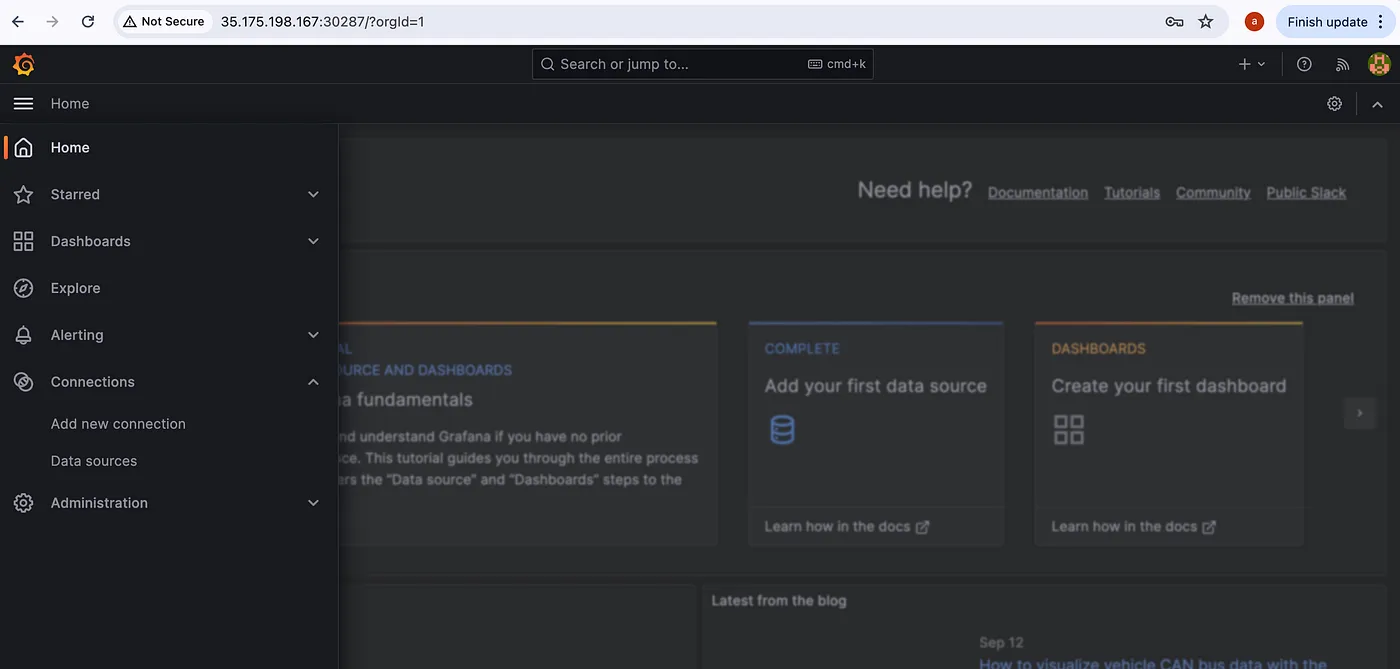
In Data sources you can see Loki has been configured as shown below
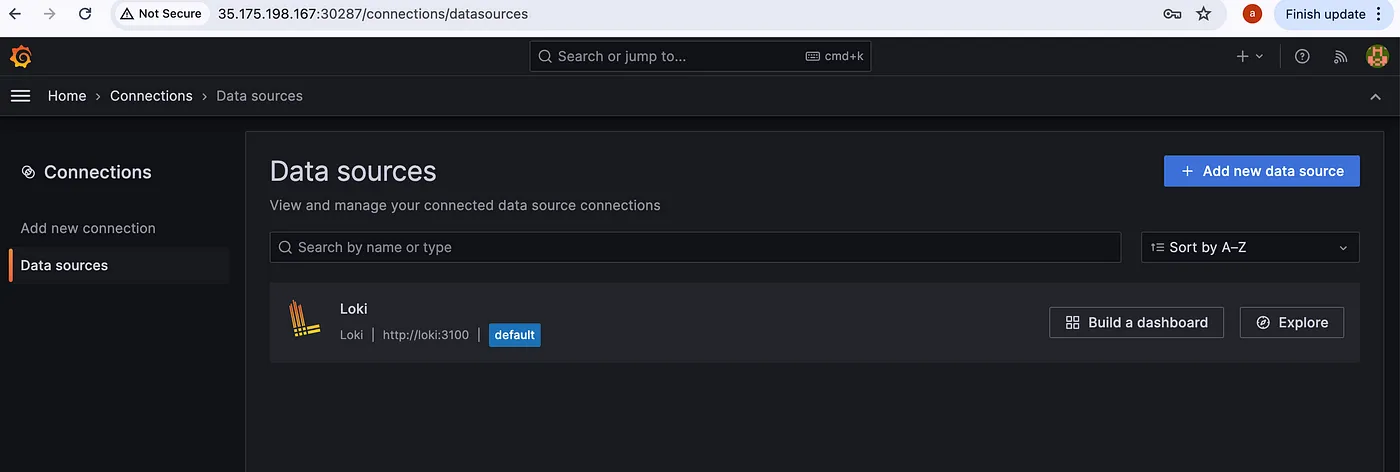
Now, check if you are getting logs or not. Go to Explore by pressing the Explore button.
To query logs select a Label and Value, Loki will collect every log in your Kubernetes cluster and label it according to container, pod, namespace, deployments, jobs and other objects of Kubernetes.
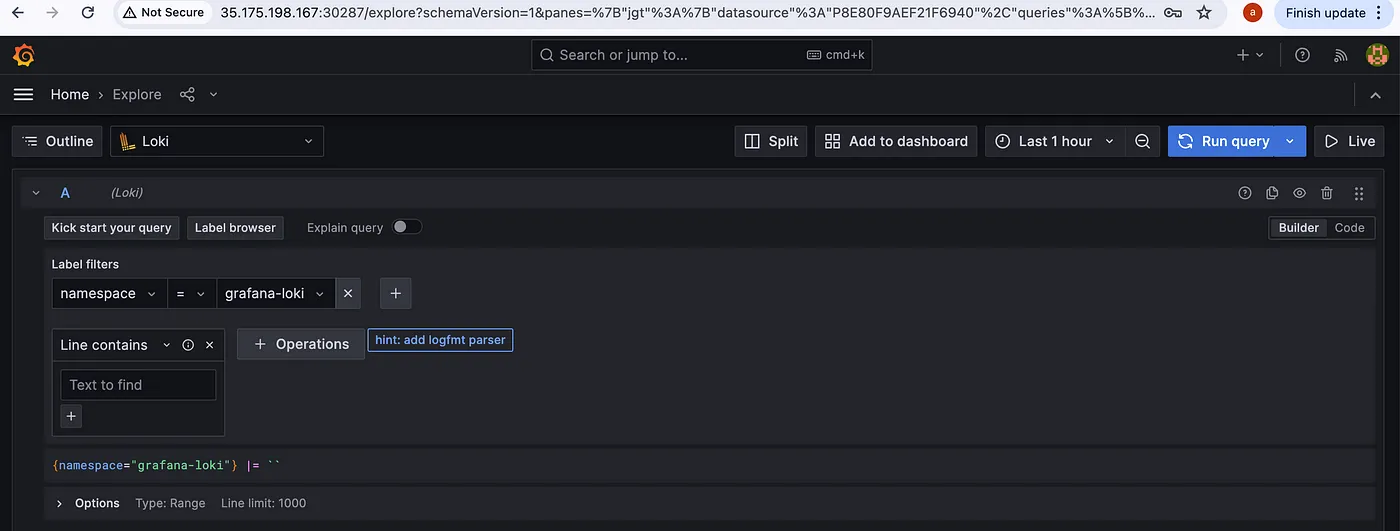
After selecting a Label(namespace) and Value(grafana-loki), press the blue button at the top right corner(Run Query)to query logs.
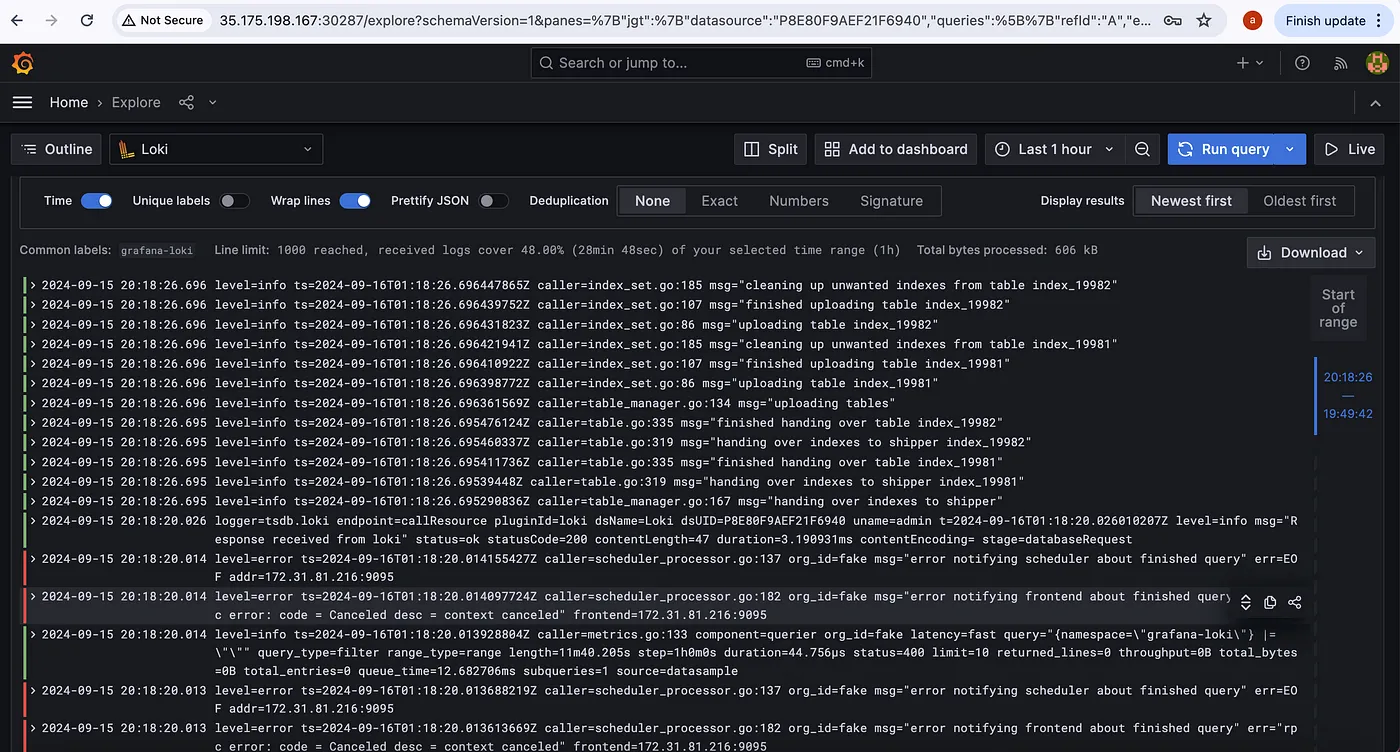
Promtail, running as a DaemonSet, will collect logs from all nodes and forward them to Loki. You can query these logs in Grafana, making it easy to monitor your Kubernetes applications.
Conclusion
In this post, we walked through how to deploy Grafana Loki on Kubernetes using Helm with customized values. By enabling Loki, Promtail, and Grafana, and disabling unnecessary components like Prometheus, Filebeat, and Logstash, we tailored the setup to meet specific logging needs.
Grafana Loki offers an efficient, scalable solution for Kubernetes log management. With this setup, you can now monitor and explore your Kubernetes logs with ease.